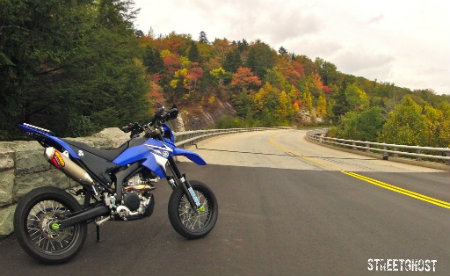When you write "enduro track", I assume that's your translation for what I'd call "trails in the woods", and you are riding the bike for recreational enjoyment, not actually racing in enduros against other competitors.
If you actually were racing it, I'd recommend you get a bike made for that right away, and the reason the guy at your local dealer tells you that is because racing a WR-250R, while possible, ain't the best place to start because you're already at a disadvantage versus a bike made for racing (and when racing, you are riding faster and harder as opposed to "I'm just out here for fun").
I wouldn't expect most parts dept. people to have a catalogue listing springs and suspension components for a WR-250R because it's a dual-purpose bike.
What I'd do is contact a shop that makes it's living modifying the suspension of dirt bikes, tell them what you want, and have them do the work.
If you insist on doing the work yourself, see if you can buy the parts from them.
You are on the right track wanting to modify the (pretty poor, compared to other dirt bikes) suspension on your bike.
Besides knobby tires and tailoring the controls and general setup of the bike for you, that's one of the major things you want sorted out.
The way the bike rolls off the showroom is best suited to very gentle trail riding, and when pushed up into just a moderated pace, it doesn't give the rider a good feeling at all.
That's because it is a very cheap suspension setup the way it comes, especially the shock absorber internals.
Getting the suspension done by a suspension shop should make that situation much better.
WR-250F sprockets will fit a WR-250R as along as you use the rear sprocket mounting bolts from the WR-250F.
I'd also buy a new WR-250R front sprocket nut at the same time since the locking tab is built into the nut and is supposed to be used just once.
My opinion:
If you are riding the street much, then the WR-250R is a good choice as it allows a good compromise of using the same bike for trail riding and street riding.
This is mainly because, even when geared down with a big rear sprocket for trail use, it can still cruise at a decent speed on the street without feeling strained or wound-out.
That is a very big deal if you ride the street a lot, as looking in your rear view mirror all the time to see if you have a car on your rear fender gets old quickly.
If you ride the street only to get from one trail to the next, get rid of the WR-250R and get a WR-250F.
Why?
The WR-250F is heavily based on the 2006-2007 YZ-250F, Yamaha's top-of-the-line dirt bike.
If you are concentrating on trail riding, the WR-250F feels about a million times better while doing that as the bike is actually made to perform there.
Straight line stability over rough ground, suspension performance, power output and power spread, light weight, and general feel are very good.
I have compared the two bikes back-to-back, and for trail riding, there is no comparison.
Also, on the subject of maintinance intervals:
It's not the case of having to do a crazy amount of work to keep a WR-250F running if you are a recreational rider out there for fun.
It requires engine oil changes, air filter service, and the same things a WR-250R requires, but, in my experience, that's it.
I've had my 2009 WR-250F since November of 2009, and I estimate I've got about 2,000 trail miles on it.
That's a good chunk of trail riding.
Other than checking the valve clearances over this past winter, the engine internals are still untouched.
